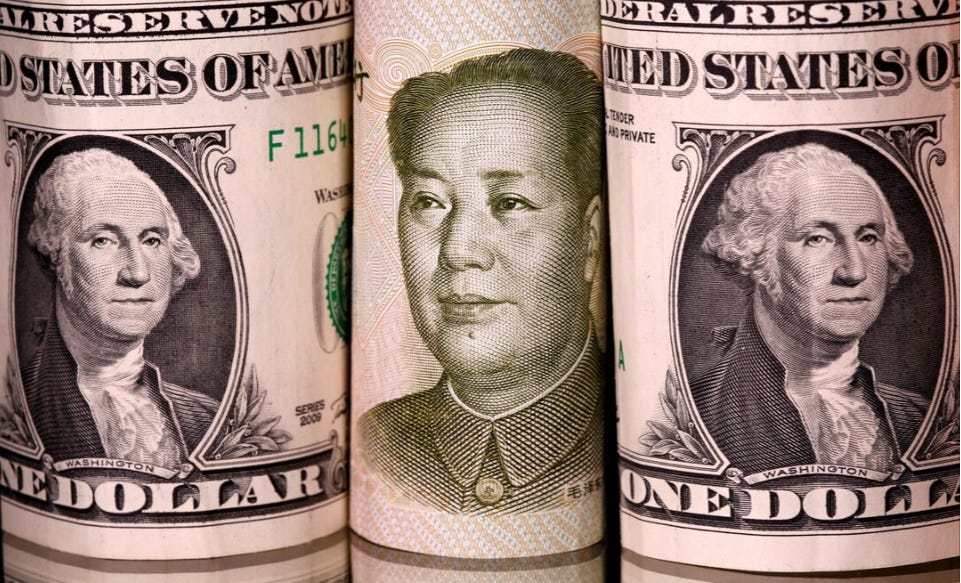Dollar Dilemma
It powers global trade and secures U.S. privilege—but the dollar’s double role is fraying. As geopolitics shift and deficits deepen, can the dollar remain both sovereign and supranational?
On May 10th, Chinese Vice Premier He Lifeng met with U.S. Treasury Secretary Scott Bessent in Geneva—a cautious first step toward taming President Trump’s tariff tempest. Since Trump’s declaration of economic war, raising tariffs on Chinese imports to 145%, Beijing has responded with composure and strategic patience. The viral meme “Do nothing. Win.” hasn’t just captured the mood—it’s become policy. While Washington lashes out, Beijing watches and waits.
But beneath this surface calm lies something deeper. The Chinese understand the dollar for what it truly is—not just a national currency, but a global operator with divided loyalties. They see what many Americans overlook: that the dollar long ago stopped working solely for the United States. In this view, the dollar has become a kind of double agent—serving the interests of global finance even when they run counter to those of its nominal home.
This uneasy allegiance has reshaped global trade, investment flows, and geopolitical strategy—often at the expense of ordinary Americans. The paradox is stark: in tailoring its currency to meet global demand, the U.S. undermines its own economic foundations. Meanwhile, others—China chief among them—seem content to watch America cinch its own monetary straitjacket, even as they quietly prepare for a world less tethered to the dollar’s shifting loyalties.
The dollar long ago transcended national borders, functioning as a kind of post-national currency—an international lingua franca spoken across the globe, yet borne by one nation alone. It is a financial Esperanto, with its grammar, syntax, and even its logic of value overwritten at the whim of its sole author.
This arrangement is historically peculiar. Past monetary systems either revolved around non-sovereign stores of value—like gold—or were anchored to an imperial state that ruled both politically and financially. The gold standard—and, in its own way, Bitcoin—represents an attempt at stateless currency, where trust in scarcity substitutes for trust in governments.
But the dollar is different: it is both deeply national and structurally global. It floats freely, issued at will, and deployed as a tool of American statecraft—yet the world treats it as a public utility to which it is perpetually entitled. In turn, the U.S. exploits this demand. Both sides have grown dependent—and emboldened—by a system neither fully controls nor truly understands.
The Catch-22 of Reindustrialization
The tension between the dollar’s global role and America’s domestic priorities becomes stark as calls to reindustrialize the U.S. grow louder. As President Trump attempts to reshape trade policy, a fundamental dilemma emerges: can the United States restore its manufacturing base, shrink its twin deficits, and still uphold the dollar’s dominance as the world’s reserve currency?
At first glance, these goals might appear aligned. Who wouldn’t want more American factories, smaller deficits, and a dollar that serves the needs of Main Street? But beneath the surface lies a contradiction built into the very structure of the global monetary system.
The U.S. issues dollars through its central bank—willing them into existence as fiat currency. But while creating dollars domestically is straightforward, supplying them to the global economy is more complex. The rest of the world cannot mine dollars or pluck them from trees. Instead, they flow outward from the U.S. through trade deficits, financial investments, foreign aid, military spending, interest payments, and remittances—an intricate system that exports dollars to sustain global trade, reserves, and debt.
However, the classic method remains simple: foreign countries produce goods—whether raw materials or finished products—and exchange them for green paper, making trade the most fundamental way to acquire U.S. dollars.
This outflow is sustained by the twin deficits: the fiscal deficit (when government spending exceeds revenue) and the current account deficit (when imports exceed exports). Together, they act like an irrigation system—sending dollars abroad to quench the world’s dependence on greenbacks. If these deficits were eliminated, the global economy would face a severe dollar drought, starving markets of the currency they rely on for liquidity.
Critics, including Trump, often frame the trade deficit as a symptom of industrial decline—a sign that America is importing too much and producing too little. But Wall Street offers a different view: the trade deficit allows Americans to consume more than they produce, a privilege extended by global demand for the dollar. What is often portrayed as a weakness is, in fact, a structural feature of U.S. financial power.
And yet, this privilege has costs. A shortage of dollar outflows would push up the dollar’s value, making U.S. exports less competitive and imports cheaper. This would deepen the trade deficit—exposing the self-reinforcing nature of the system. Global dollar demand requires constant supply, and any attempt to balance the books is met with systemic resistance.
A striking illustration of this dynamic appeared in the 1990s, when the U.S. made notable progress in reducing its federal budget deficit. But as the fiscal deficit shrank, the trade deficit ballooned. In 1993, it was roughly $65 billion (1% of GDP); by 2000, it had soared to over $380 billion (3.7% of GDP). One deficit gave way to another, preserving the global dollar flow and revealing how the system rebalances itself.
This is the core paradox: efforts to fix domestic imbalances intensify the international ones. The dollar’s global role acts like a gravitational field, pulling the U.S. economy toward external deficits. Unless alternative mechanisms are found to distribute dollars abroad, any serious effort to reduce America’s trade imbalance would threaten the very system the dollar supports.
The Dollar Pipeline — Twin Deficits and the Machinery of Global Flows
To dive deeper into how the U.S. supplies the world with dollars, it’s necessary to examine the U.S. balance of payments, which consists of two interconnected components: the current account and the financial account. These accounts function like a seesaw: when one side tips into deficit, the other must swing into surplus. This isn’t a matter of choice—it’s an accounting identity. Every outflow from one account must be matched by an inflow into the other, ensuring balance in the system, with only minor exceptions for errors and omissions.
The current account tracks the trade of goods and services, along with investment income and transfers. While often used interchangeably with the term “trade deficit,” the current account is broader, encompassing not only the balance of trade but also income from investments and financial transfers.
When the U.S. imports more than it exports, it runs a current account deficit—sending dollars abroad in exchange for goods, services, and capital income. In 2023, this resulted in a current account deficit exceeding $1 trillion. The financial account, by contrast, records the corresponding surplus: foreign entities using those dollars to acquire U.S. assets such as Treasury bonds, equities, and real estate.
But these dollars don’t re-enter the domestic U.S. economy in the usual sense. Foreign investors, including central banks, often hold U.S. assets abroad—as reserves, as stores of value, or as collateral in international lending. The dollars are recycled, not repatriated. They remain embedded in global financial circuits, sustaining the dollar’s role as a medium for trade, a unit of account, and a reserve currency. This reinvestment supports the international demand for dollars—not because the dollars return to the U.S. consumer economy, but because they remain useful beyond its borders.
Can the World Be Supplied with Dollars Without a Current Account Deficit?
In a recent paper, economist Maurice Obstfeld explores an intriguing possibility: that the world’s demand for dollars might be met without America having to run persistent trade deficits. Instead of relying on imports and consumption to send dollars abroad, the U.S. could theoretically become a net buyer of foreign assets—real estate, stocks, bonds—effectively exporting dollars by investing abroad.
This would represent a complete inversion of the current arrangement, where foreigners purchase U.S. assets, creating a financial account surplus for America. Under Obstfeld’s model, however, the U.S. would run a financial account deficit, as dollars would be flowing out to purchase foreign investments rather than flowing in from foreign purchases of American assets.
But this elegant inversion runs up against a hard constraint: the basic accounting identity that governs international payments. Again, the system operates like a seesaw: when one side tips, the other must rise to restore balance. If the U.S. suddenly runs a financial account deficit—sending capital abroad—it must simultaneously run a current account surplus. In other words, America would have to export more goods and services than it imports, transforming itself from the world’s consumer of last resort into an export-driven manufacturing powerhouse.
In theory, this is possible, and it seems to be the vision many in the Trump Administration hold dear: U.S. reindustrialization while maintaining dollar hegemony. In practice, however, it would require a massive economic transformation—reduced consumption, increased savings, a revitalized industrial base, and a fundamentally different orientation of the U.S. economy.
To achieve this, America would need to turn forward to the past, reclaiming its pre-World War II identity as a global manufacturing powerhouse. This shift would take decades, and during the transition, global demand for dollars would remain constant—even as their supply began to shrink due to the inevitable decrease in the U.S. trade deficit.
Today, the U.S. finances its trade deficit by attracting foreign capital, which flows into American markets, inflating the value of stocks, bonds, and real estate. This influx has benefited many affluent Americans by boosting retirement portfolios and elevating home values, key pillars of financial security. However, the current pattern comes with costs: while Wall Street prospers, Main Street has suffered. The manufacturing base has withered, and the wealth generated from inflated asset prices has largely concentrated at the top.
Obstfeld’s vision of domestic renewal while maintaining dollar supremacy presents an alluring ideal, yet the costs of such a transformation would be real. Wall Street would bear the brunt, with financial markets contracting and the balance of power tilting toward labour.
The implicit bargain that has underpinned the dollar’s dominance—America tolerating chronic trade deficits in exchange for the privilege of issuing the world’s reserve currency—has always been asymmetric. While Wall Street gained yachts, Main Street lost factories. A rebalancing of this system could bring some of the long-overdue benefits to the American public, but it would come at a steep price, both domestically and globally.
If the U.S. were to reverse this pattern and become a net exporter of capital, the flow of dollars into U.S. markets would shrink. As a result, asset prices would fall. The stock market would dip, housing prices would decline, and many well-off Americans would see their wealth, tied up in retirement savings and home equity, diminish.
Yet, for younger and working-class Americans, this shift could provide long-awaited relief. Lower housing costs, the revitalization of U.S. industry, and a more production-focused economy could follow, benefiting those who have long been excluded from the windfall of speculative financial gains.
At the same time, the broader global economy would face its own reckoning. Countries that have relied on U.S. consumer demand and capital inflows might have to adjust to a world where they are no longer running trade surpluses with the U.S. The global imbalance, once seen as mutually beneficial, would give way to new challenges, including deindustrialization and rising financial strains abroad.
As appealing as Obstfeld’s proposed shift may seem to many Americans, the transition would be slow and politically fraught. Replacing America’s trillion-dollar trade deficit with a trillion-dollar financial deficit demands a two-trillion-dollar adjustment in order to match current outflows of dollars to the world.
While such an idea is politically implausible in the U.S., imagine, as a thought experiment, a twenty-year plan to shrink the trade deficit by $100 billion annually. By year five, the deficit is halved—progress for the U.S., but a challenge for the world. As the global supply of new dollars contracts, scarcity drives the dollar’s value higher. A stronger dollar makes U.S. exports less competitive, undermining the very industrial resurgence the transition requires. The process begins to devour itself.
By year ten, the U.S. would in theory achieve external balance—no net trade deficit, no net capital inflows. But reaching this point would be like a monster truck pulling an increasingly weighted drag sled: each foot forward amplifies the burden. The stronger the dollar becomes, the harder it is to export. What started as a manageable rebalancing soon becomes a grinding, uphill struggle, defying political reality. Between year five and ten, the only plausible path forward would be some form of intervention to weaken the dollar—an intentional effort to tip the scales and keep the wheels turning.
Achieving the Herculean task of balancing its current account would be a domestic triumph for America. But for the global financial system, it would be a crisis. The pipeline of fresh dollars would dry up. Global monetary irrigation would falter. The system’s most vital resource would vanish—even as the world’s demand for it accelerates.
As early as year five, a fork in the road emerges. With the U.S. no longer supplying dollars through trade deficits, the world would be forced to find an alternative. It would not wait another decade for the U.S. to resume exporting dollars—this time through outbound investment, as Obstfeld envisions.
Assuming the fiscal deficit has also been reined in under this scenario, the world would be cut off from its primary sources of fresh dollar supply. The dilemma becomes impossible to ignore. The dollar is trapped between two irreconcilable roles. To serve domestic industry, it must weaken and withdraw. To serve global finance, it must continue to flow outward—sustained by deficits, bubbles, and distortion.
In the long run, the dollar cannot serve both masters. Something must give.








While it is true that the dollar serves mutually contradictory purposes, nobody of influence and authority wants a replacement for the dollar or a dollar crash or whatever.
The world doesn't need an alternative to dollars for temporary liquidity, because there are a boatload already in existence (USA debt is already 100% of GDP) and those can be multiplied into Euro dollars or other types of credit instruments. What will eventually happen is that people worldwide will come to think that owning hard assets (buildings, factories, infrastructure, mines) is better than owning dollar denominated credit instruments subject to counterparty and dollar devaluation risk, and that will result in wholesale repudiation of the dollar in favor of creating these hard assets. People will trade their dollars for whatever USA can export (mostly commodities like oil, natural gas, mining products, timber, agricultural products, bulk chemicals, etc) to support process of creating hard assets.This will cause US dollar to crash as some rush to exchange dollars for other currencies, USA exports and inflation to soar as other rush to spend dollars in USA buying those commodities just listed, USA imports and financial assets to crash, USA current account deficit to end. USA budget deficit is an internal matter: either cut it or inflation becomes extreme. Typical financial crisis, as seen in Britain, Argentina, Turkiye, etc, etc.
tl:dr: there is nothing magical about US dollars any more than gold or beanie babies or bitcoin. Price is high only as long as everyone agrees it is high, and that isn't necessarily forever, as the examples of beanie babies or gold in the years 1980->2000 show.